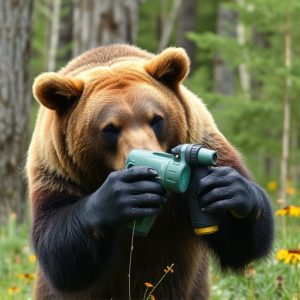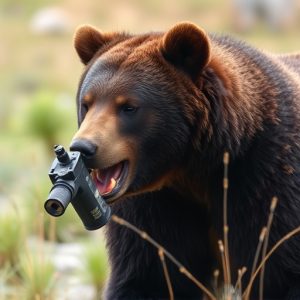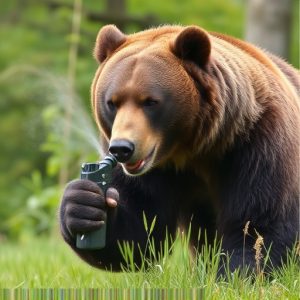Bear Deterrent Spray: Range, Legalities, and Alternative Strategies
Bear spray, an effective deterrent for bears in sensitive areas, relies on correct application, wind…….
Bear spray, an effective deterrent for bears in sensitive areas, relies on correct application, wind conditions, and a 20-30 foot (6-9 meter) range. Local regulations govern its use, with some regions prohibiting it to protect wildlife and humans. Understanding these laws is crucial before venturing into bear country, especially where it's banned. Effective usage requires aiming at sensitive areas like the face and eyes from a distance, while terrain, weather, and wind can impact performance. Alternative safety measures are vital in areas where bear spray is prohibited, focusing on noise-making, group hiking, and understanding local guidelines regarding its use.
Bear deterrent spray offers crucial protection in areas inhabited by bears, but understanding its range and effectiveness is vital. This comprehensive guide explores bear spray’s composition, legal considerations, and maximum range. We’ll navigate factors like terrain, weather, and distance, providing tips for accurate use. Additionally, we discuss when alternative measures might be necessary, especially in situations where bear spray is either prohibited or less effective due to local regulations.
- Understanding Bear Spray: Its Composition and Effectiveness
- Legal Considerations: Where Is Bear Spray Allowed and Prohibited?
- Maximizing Range and Accuracy: Tips for Effective Use
- Factors Influencing Bear Spray Range: Terrain, Weather, and Distance
- Alternative Measures: When Bear Spray Might Not Be Enough
Understanding Bear Spray: Its Composition and Effectiveness
Bear spray, also known as bear deterrent spray, is a popular tool for outdoor enthusiasts navigating areas frequented by bears. Its primary purpose is to protect individuals and their camps from aggressive bear encounters. This aerosol spray contains capsaicin, the active ingredient found in chili peppers, which irritates a bear’s eyes, nose, and throat when inhaled. This irritation triggers a distraction or temporary incapacitation, allowing the user to escape or defend themselves.
While bear spray is highly effective as a deterrent, it’s crucial to understand its limitations. The spray’s effectiveness depends on factors like proper usage, wind direction, and proximity to bears. Maximum range protection typically varies between 20 to 30 feet (6 to 9 meters), but this can be reduced by windy conditions or the user’s improper application. It’s important to note that bear spray is not a guaranteed solution; its effectiveness depends on using it correctly and applying it in close proximity to an approaching bear. Additionally, regulations regarding bear spray differ across regions, with some areas prohibiting its use entirely to prevent potential harm to wildlife and humans alike, so it’s essential to check local guidelines, including where bear spray is prohibited.
Legal Considerations: Where Is Bear Spray Allowed and Prohibited?
In many regions, bear deterrent spray is a popular and effective tool for personal safety in areas known for bear populations. However, its use comes with legal considerations that vary widely across different jurisdictions. Understanding where bear spray is both allowed and prohibited is crucial before venturing into potential bear country.
While some places have no restrictions on carrying and using bear deterrents, others have strict rules. For instance, many national parks and wilderness areas allow the use of bear spray for self-defense but have specific regulations regarding where and how it can be deployed. In urban or densely populated areas, there might be complete bans due to safety concerns and potential harm to bystanders. It’s essential to check local laws and guidelines before acquiring and using bear deterrent spray to avoid any legal repercussions.
Maximizing Range and Accuracy: Tips for Effective Use
Maximizing the range and accuracy of bear deterrent spray is key to ensuring its effectiveness in potentially life-saving situations. When using bear spray, it’s important to remember that wind conditions can significantly impact its reach. For optimal results, aim for the face and eyes of the bear, as these areas are highly sensitive. Hold the canister upright and spray in short bursts at close range, around 20-30 feet (6-10 meters), allowing the spray to spread naturally. This technique ensures a direct hit, maximizing the deterrent effect.
To avoid where bear spray is prohibited, always check local regulations before heading into bear country. Some areas have restrictions on carrying and using bear deterrents due to conservation efforts or sensitive ecosystems. Understanding these rules is crucial for responsible outdoor recreation and minimizing potential harm to both humans and wildlife.
Factors Influencing Bear Spray Range: Terrain, Weather, and Distance
The range at which bear deterrent spray can be effective is influenced by several key factors, including terrain, weather conditions, and distance between the user and the bear. In general, bear spray has a maximum recommended range of around 30 feet (10 meters), but this can vary significantly based on environmental conditions.
Rough or uneven terrain, such as steep slopes or dense brush, can impede the spray’s trajectory, reducing its effective range. Wind and weather conditions, including humidity and temperature, can also affect the spray’s dispersion and penetration. Additionally, the distance at which the spray is deployed plays a crucial role in its overall effectiveness. It’s important to note that where bear spray is prohibited or regulated varies by location, so users should always check local guidelines before carrying and using such deterrents, especially in areas known for bear activity.
Alternative Measures: When Bear Spray Might Not Be Enough
In some areas, carrying bear spray might not be sufficient or permitted as a primary means of protection. While it’s an effective deterrent for close encounters, there are circumstances where bears have shown resistance or when spray isn’t readily available. In such cases, alternative measures become crucial. Knowing local regulations regarding bear spray is essential; certain parks or wilderness areas may prohibit its use to protect sensitive ecosystems and wild animals.
Alternative strategies include making noise while hiking to deter bears from surprise attacks, carrying a loud whistle or singing to alert bears of your presence. Additionally, traveling in groups increases visibility and can deter aggressive behavior. Always check local guidelines and consider the terrain and bear activity levels before choosing a protection method, as where is bear spray prohibited, other tactics must be employed to ensure safety during outdoor activities.
Bear spray is an essential tool for outdoor enthusiasts in bear country, offering a safe and effective deterrent against attacks. However, understanding its range limitations and legal restrictions, as discussed, is crucial for responsible use. By mastering techniques to maximize accuracy and recognizing scenarios where bear spray might not be sufficient, individuals can enhance their safety in potential encounters. Staying informed about local regulations, especially regarding where bear spray is prohibited or required, ensures a responsible and enjoyable outdoor experience.


